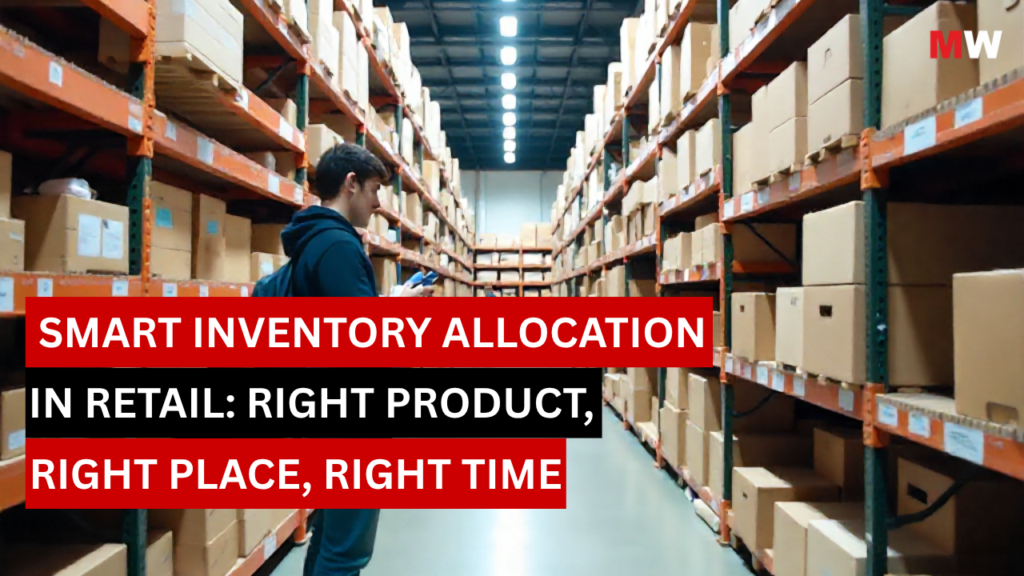In today’s fast-paced business world, inventory is no longer just “stock sitting in a warehouse.” It is a strategic resource—one that directly impacts customer satisfaction, brand loyalty, and profitability. By 2025, companies that fail to modernize their inventory allocation strategies risk losing customers to more agile competitors.
The golden rule? Right product, right place, right time.
This blog will explore how inventory allocation is reshaping industries, the role of technology, tools that simplify the process, and why mastering this science is the difference between thriving and merely surviving.

Introduction:
Have you ever walked into a store or tried shopping online only to find your favorite product out of stock? Frustrating, right? On the flip side, companies also suffer when they have too much unsold stock. Meanwhile, across town, the same store chain has hundreds of pairs sitting unsold.
This mismatch is what poor allocation looks like. It frustrates customers and leaves businesses with dead stock, lost sales, and damaged reputation.
On the flip side, when inventory is allocated smartly, customers find what they want, stores reduce waste, and businesses maximize profits.
That’s why in 2025; inventory allocation is no longer just an operational task—it’s a business game-changer.

Inventory Allocation and Replenishment in the Retail Industry
We are going to discuss smart inventory allocation for sectors like apparel, footwear, eyewear, cosmetics, and more.
To begin with, we need to understand the basics: what is replenishment, what is inventory allocation, and why are they important?
- Inventory allocation in retail refers to the distribution of stocks across different retail stores. Depending on demand, the supply varies from one location to another.
- Replenishment, on the other hand, is the process of restocking a retail store to maintain optimal inventory levels and meet customer needs.
The optimization of allocation and replenishment ensures that businesses prevent sales loss, avoid stockouts, and keep customers satisfied.
Today, leading companies like Increff are pushing the boundaries with advanced allocation models. At the same time, competitors such as Manhattan Associates and Oracle Retail provide robust retail inventory solutions. Each comes with its strengths—while some focus on AI-driven demand sensing, others emphasize deep integration with ERP systems.
This competitive landscape makes it clear: the retailers who adopt smarter allocation tools will stand out in 2025 and beyond.
Understanding the True Value of Resource Allocation:
If you are interested in knowing the true and efficient value of resource allocations, here are the key benefits explained in simple, practical terms:
Optimization and Utilization of Resources:
Working on the right project, at the right time, with the right people creates a powerful balance. This unites crucial project components and helps reach goals faster.
Lighter in the Pocket:
Smart allocation saves money. With the right team size, you avoid paying extra for underutilized resources. Proper planning ensures high-quality work, no rushed deadlines, and happier clients.
Example: An eCommerce business selling clothing may see higher winter jacket demand in colder regions. A dynamic allocation system will adjust stock accordingly.
Awareness of Resources:
Resource allocation shines a light on employee visibility—their skill sets, seniority, availability, and hidden capacity. This avoids blind spots when assigning projects.
Managing Inventory Constraints:
It’s common to feel like more people are needed at the start of a project. But with proper forecasting, you often realize fewer resources are required. Planning prevents shortages, overstaffing, and mid-project panic.
On-time Delivery with Quality:
Correct resource allocation means the right number of people with the right skills, leading to on-time, high-quality delivery. This also prevents conflicts and burnout. Smart tools like Increff integrate with eCommerce platforms like shopify to guarantee fast fulfillment without sacrificing quality.
Improvised Team Morale:
When tasks are distributed fairly and workloads are balanced, team members feel valued. This creates a positive environment, boosting dedication and motivation.
Tools help businesses manage teams and marketing campaigns alongside inventory operations, creating a unified workflow and improving morale.

The Role of Technology in Retail Inventory Allocation:
In the current pace of retail, technology is the driving force behind intelligent inventory allocation. Consumers want to find products at the right time, whether they are buying through marketplaces, online, or in-store. To serve this purpose, retailers require more than manual planning—they require AI-fueled insights, automation, and real-time visibility. This is precisely where Increff has rewritten the rulebook.
Making Inventory Management Stable:
Monitoring stock across multiple stores is exhausting without automation. Modern tools like Increff Smart Merchandising help:
- Track stock levels automatically across stores
- Send alerts when inventory drops below thresholds
- Maintain minimum stock levels per product
These features prevent stockouts and excess inventory simultaneously.
Demand Forecasting Accuracy:
Tech-powered demand forecasting allows retailers to predict what customers will want, where, and when. This ensures:
- The right product is in the right location at the right time.
- Stores don’t hold unnecessary stock.
- Inventory wastage is reduced while profits rise.
Reducing Inventory Losses:
With predictive analytics, businesses not only forecast demand but also reduce shrinkage and overstocking. This means retailers can:
- Prevent stockouts (lost sales).
- Avoid holding dead stock (capital loss).
- Improve supply chain resilience.

Why Increff is the Leader in Smart Inventory Allocation
Increff’s solutions are designed specifically for modern retail realities. Instead of heavy ERP modules or generic inventory tools, Increff provides modular, retail-first platforms that optimize allocation and replenishment end to end.
Increff not only provides you smart inventory but also adds value to it from optimizing stocks minimizing stock outs to enhancing merchandise variety. It also provides you with store style rankings which are based on ROS. At Increff it does identify pivotal and non- pivotal sixes for each retail with its attribute. Maintaining optimum depth for each sized SKUs at each retail store with diversified size sets of different retail stores for different articles within the same categories. Here are some more values that Increff add towards a smart inventory
1. Increff Smart Merchandising
- Tracks stock levels automatically across the entire chain of stores.
- Sends alerts when stock falls below thresholds.
- Avoids overstocking and stockout.
- Optimizes assortment by determining the correct size mix and top sellers for each zone.
Impact: Customers always get what they want, while stores minimize waste.
2. Increff OMS (Order Management System)
- Directs and distributes orders in real time to the optimal fulfillment site.
- Monitors SKUs with rich attributes—size, dimensions, expiry.
- Supports B2C shipping from B2B warehouses.
- Facilitates sophisticated workflows such as virtual combo SKUs.
Impact: Intuitive, efficient fulfillment that delights customers without increasing logistics expense.
3. Increff WMS (Warehouse Management System)
- Makes inbound and outbound stock movements a breeze.
- Handles both B2B and B2C businesses.
- Makes returns—a forgotten cost center—smooth sailing.
- Grows with ease, without the bloat of ERP warehouse modules.
- Impact: Warehouses operate leaner, faster, and more profitable
4. Omnichannel Fulfillment
- Endless aisle: Have customers order what is not in-store and receive it by ship from elsewhere.
- Self-checkout: Quick in-store experiences.
- Virtual trial rooms: Increase confidence and minimize returns in categories such as apparel.
Impact: Seamless shopping experiences both online and offline.

Conclusion:
In the modern retail and eCommerce landscape, smart inventory allocation is no longer optional—it’s a critical driver of business success. Ensuring the right product reaches the right place, at the right time not only prevents stockouts and dead inventory but also enhances customer satisfaction and loyalty.
By combining inventory solutions with platforms that manage teams, marketing campaigns, shipping, and customer communication, businesses can achieve a seamless operational ecosystem. This holistic approach ensures that every aspect of the supply chain—from production to delivery to customer service—is aligned and efficient.
In 2025 and beyond, companies that adopt smart allocation practices and embrace integrated technologies will not only maximize profits but also create memorable customer experiences. The future belongs to those who can balance resources, anticipate demand, and respond with agility—making smart inventory allocation the cornerstone of sustainable growth.
For retailers who want accuracy, efficiency, and scalability, Increff provides the most advanced allocation and inventory management ecosystem available today.
FAQs:
Q1. How to achieve balanced inventory allocation and replenishment?
Balanced inventory allocation and replenishment mean keeping the right amount of stock in all stores or warehouses at all times. You can:
- Provide a single source of truth for your supply chain team, so everyone has accurate, up-to-date information.
- Improve decision-making with AI and automation, helping you act faster and smarter.
- Balance stock movements by recommending optimal inventory levels across locations.
- Predict customer demand more accurately to avoid stockouts or excess inventory.
Q2. What are the benefits you get from a smart inventory allocation at Increff?
Using smart inventory allocation solutions like Increff can provide several advantages:
- Maximize profits by optimizing inventory and reducing waste.
- Ensure customer satisfaction by providing the right product at the right time.
- Reduce stock-outs and prevent lost sales caused by empty shelves.
- Optimize resources such as warehouses, transportation, and production capacity.
- Build supply chain resilience, allowing your business to respond faster to market changes.
Q3. Explain the elements of smart inventory: right product, right place and right time.
Smart inventory has three key elements:
- Right Product: Ensure the products available match customer needs and preferences, whether in style, size, or category.
- Right Place: Distribute inventory to stores, warehouses, or online channels where customers are most likely to purchase.
- Right Time: Deliver products when customers expect them, aligning with demand patterns, promotions, and seasonal trends.
Q4. What are the things to consider before you choose an inventory allocation tool for your project?
Choosing the right tool is crucial for smooth operations. When evaluating software for inventory allocation, consider:
- A centralized resource pool to manage all teams and inventory from one platform.
- Tools for scheduling and planning, ensuring optimal stock distribution.
- Real-time data visibility to monitor inventory and make informed decisions.
- Data visualization for quick insights into stock levels and trends.
- Analysis and reporting features to track performance and forecast demand.
- Monitoring and tracking capabilities for accurate, smart inventory management.
- Privacy and security to protect sensitive business data.
- Customization options to adapt the tool to your business processes.
- Cost and budgeting considerations to ensure the software is affordable.
- User-friendliness so your team can adopt it easily.
- Technical support for troubleshooting and smooth operation.
- Integration capabilities to connect with other systems like accounting, CRM, or eCommerce platforms.








